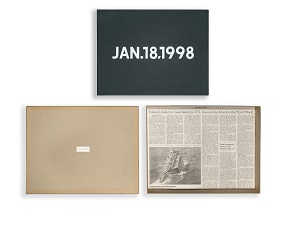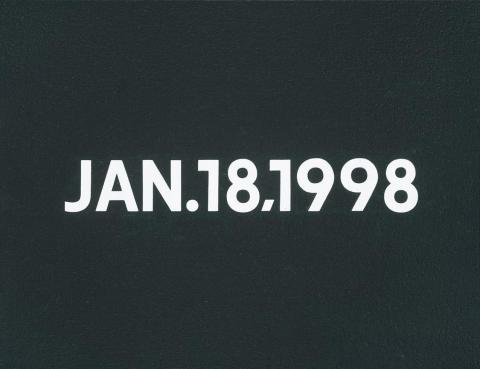JAN. 18, 1998, 1998
ON KAWARA
(from TODAY SERIES)
Liquitex on canvas and handmade cardboard box with newspaper clipping from the New York Times
26.0 x 33.5 cm
signed verso: On Kawara
label attached to stretcher verso: “Sunday.” / JAN.18,1998. “TODAY” Series No.1, 1998. Painted by On / Kawara in New York City. Liquitex on canvas. 10” x13”.
Hauser & Wirth, Zürich
Private collection, Melbourne, acquired by
Sarah Cottier Gallery, Sydney as agent for the above
Hauser & Wirth at Art 33 Basel, Basel, Switzerland, 12 – 17 June 2002
dh170360 - On Kawara Canvas and Box.jpg

cardboard box and newspaper clipping
from The New York Times
Using reduced material means, the works of On Kawara’s Today series are products of a mindful communion of time and space within the realm of one individual’s experience, all the while sharing in a universal collective consciousness. Minimalist and cerebral, the Today paintings are journalistic impulses expressed through a codified methodical process, all following the same format: three alphabetical letters and six Arabic numerals arranged in a sequence that describe the painting’s date of creation stencilled in white synthetic paint in the centre of a monochrome canvas, changing only slightly in colour, size, and syntax. On backgrounds of the artist’s own hand mixed colour – in a limited palette of red, blue or, most commonly, a deep grey, the Today paintings can be grouped in pairs, week or decade long sequences, or simply exist as stand-alone moments authenticated by their associated paperwork. Jan. 18, 1998, 1998 was the first date painting Kawara completed in that year, as the No. 1 inscribed on the reverse of the artist’s label indicates, painted on a Sunday (also included in the subtitle of the painting) in New York City, where the artist maintained a home.
Unusual in the context of Kawara’s wider oeuvre, the Today series used the traditional medium of painting. Kawara was dedicated to this medium’s specific qualities at a time when the relevance of painting was under philosophical and material siege, resulting in paintings that were all two-dimensional and rectilinear, painted with accumulative layers of paint (in the manner of Japanese lacquer but creating a matte surface). Kawara’s meditative, repetitive process minimised the trace of his hand, confining his artistic intervention to the choice of date, typeface, article and speed of production – if the painting was not completed by midnight, it was destroyed. The syntax of each date was determined by the language of the country the peripatetic artist was visiting at the time of painting; if the country did not use alpha-numerical script, Kawara used Esperanto. While his New York Conceptualist peers ascribed to a philosophy of painting that was dissociated from any external referent, existing solely in and of itself, the numbers and letters of Kawara’s dates were not mere symbols, but always retained their semantic value.
To store his ever-growing collection of Today paintings, Kawara custom-made individual cardboard boxes which were lined with a copy of the day’s newspaper and neatly labelled on the front with a typewritten label. While the clipping provides a geo-political and social context for each date, the paintings were not intended solely as a memorialisation of these dates. The clipping serves instead as an indexical authentication of the artist’s inhabitation of that specific moment and place in time.1Kawara’s practice is anchored in an existential meditation on presentness. Robert Storr, writing of an example of the Today series exhibited at the Museum of Modern Art, suggested a humanist motive to Kawara’s practice, ‘to remind us how time’s passage simultaneously isolates individuals in their own reality and binds them to a collective reality’2
The Today paintings are a reification of the artist’s personal experience through the Western construct of linear time. The significance of these paintings lies in the fact that Kawara has made the painting’s own date of execution the painting’s sole figurative imagery, elevating it from a post-script and inscribing the painting solidly within space and time, and also within the artist’s own archival deluge.3Currently, these are all dates the artist has shared with us, a fact that will dwindle as time continues its inexorable march. Comprised of moments arbitrarily extracted from the space-time continuum, the seriality of Kawara’s Today paintings is at once awe-inspiring and banal, its chronological irregularity enabling individual appreciation of each painting. Including over 3,000 paintings (out of over 17,000 possible days between 1966 and 2013) the magnitude of Kawara’s conceptual commitment is staggering. Although the paintings necessarily resemble each other, no two are the same.
Created in parallel to the Today series, Kawara’s telegrams̶ two of which are included in this auction̶ each detailed a simple message ‘I am still alive’. These missives were regularly transmitted by the artist to acquaintances around the world. They combined an expression of personal and profound truth ̶ an affirmation of the artist’s selfhood ̶- with an impersonal and almost immaterial form. Only attaining a physical expression upon receipt of its message, these works explore the notion of authorship in a way that transcended the Today series, which had always been anchored in the artist’s presence and the conceptual commitment he upheld throughout his lifetime.
1. Chiong, K., ‘Kawara On Kawara’, October, The MIT Press, Massachusetts, vol. 90, Autumn, 1999, p. 50
2. Storr, R., On the Edge: Contemporary Art from the Werner and Elaine Dannheisser Collection, The Museum of Modern Art, New York, 1997, pp. 72 – 73
3. Rorimer, A., ‘The Date Paintings of On Kawara’, Art Institute of Chicago Museum Studies, Chicago, vol. 17, no. 1, 1991, p. 122
LUCIE REEVES-SMITH
